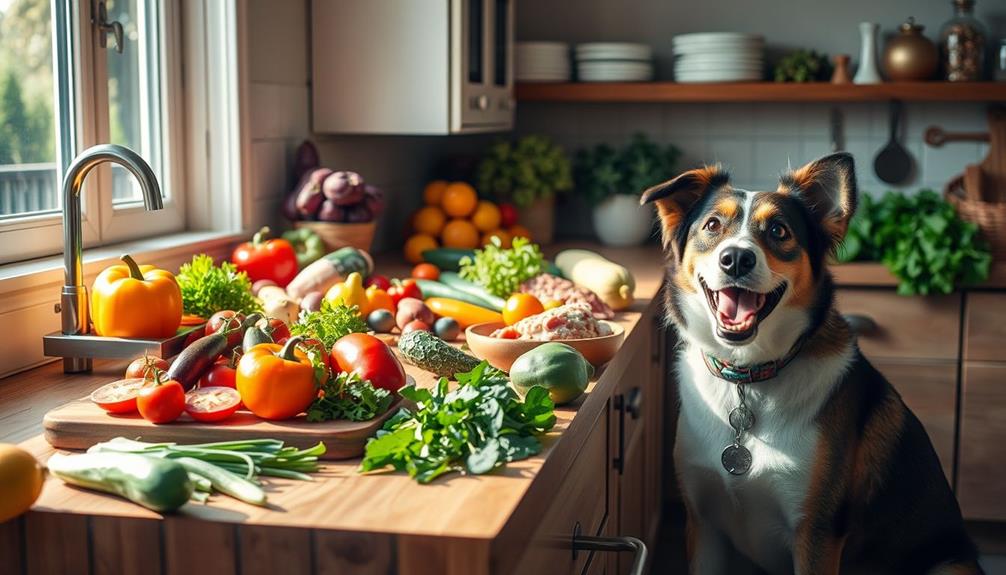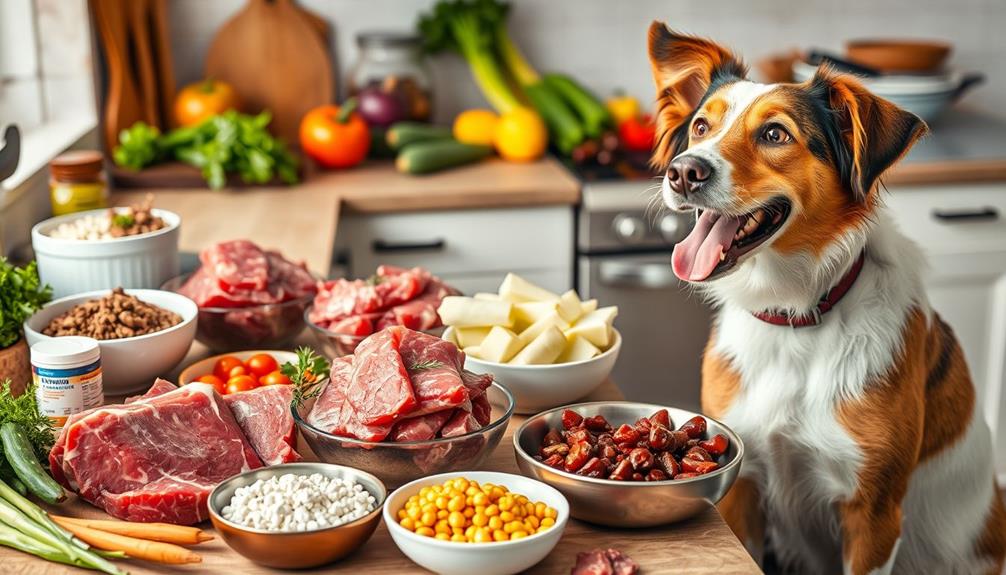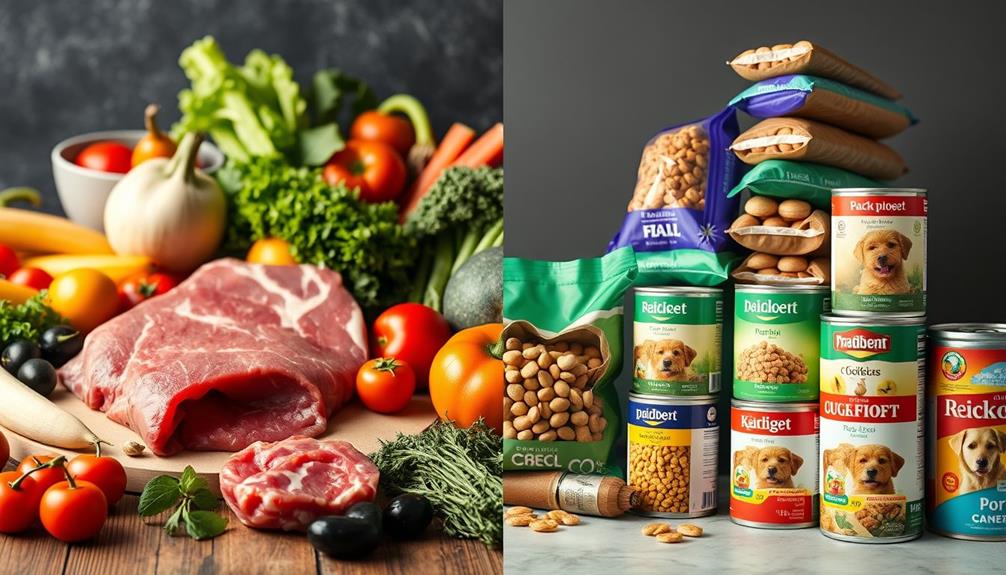Switching your dog to a raw food diet is simple and rewarding. Start by mixing 75% kibble with 25% raw food for the first three days, then gradually increase the raw portion. By days 7 to 9, aim for 75% raw. Monitor your dog's health and stool consistency during this process. Add flavors like low-sodium bone broth to enhance meals and keep it interesting. Make sure fresh water is always available and expect some detox symptoms as they adapt. With the right approach, you can reveal the many benefits of raw feeding for your furry friend. There's much more to explore on this journey. Transitioning to a raw food diet for dogs can significantly improve their overall health and well-being. You may notice improvements in their coat, energy levels, and digestion. It’s important to do your research and consult with a veterinarian to ensure your dog is getting all the necessary nutrients from their new diet. Remember to introduce new foods gradually and pay attention to any allergic reactions or sensitivities. With time and patience, you and your dog can enjoy the benefits of a raw food diet for dogs.
Key Takeaways
- Gradually transition by starting with a mix of 75% kibble and 25% raw food for the first three days.
- Monitor your dog's response, adjusting the diet to 50% raw from days 4 to 6, then 75% raw from days 7 to 9.
- Expect detox symptoms like loose stools or vomiting; manage these with plain canned pumpkin and monitor stool consistency.
- Keep fresh water available, as dogs may drink less with a raw diet due to higher moisture content in food.
- Introduce a variety of protein sources and use flavor enhancers to make raw meals appealing and exciting for your dog.
Understanding the Raw Diet Concept
Understanding the raw diet concept for dogs starts with recognizing that this approach mimics the natural eating habits of wild canines. A raw dog food diet typically consists of uncooked meat, bones, fruits, and vegetables, aiming to provide ideal health and nutrition.
When you think about shifting to raw dog food, it's important to know the right balance. A well-structured raw diet for dogs should include around 70% lean muscle meat, 10-15% raw meaty bones for calcium and dental health, and 10-20% vegetables for fiber and necessary nutrients.
Additionally, incorporating a variety of protein sources and including organ meats is essential for a complete dog meal, as it helps prevent nutritional deficiencies and promotes overall well-being beneficial for overall health.
Feeding raw can greatly enhance your dog's digestive system. Many owners notice improvements like healthier skin and coat, reduced allergies, and smaller, firmer stools compared to kibble diets.
However, it's vital to maintain a balanced raw diet to prevent nutritional deficiencies. Incorporating a variety of protein sources and including organ meats is essential for a complete dog meal.
As you explore this feeding method, remember that the goal is to provide your furry friend with a natural, wholesome diet that closely resembles what wild dogs would eat.
Gradual Transition Steps
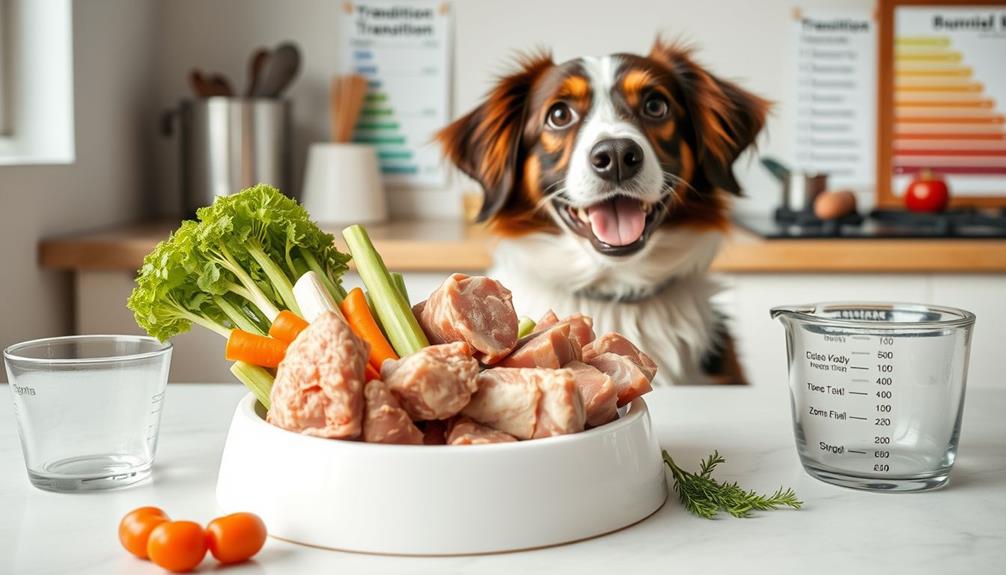
Shifting your dog to a raw food diet requires a careful approach to guarantee a smooth adjustment.
Start with a gradual change by mixing 75% kibble and 25% raw food for the first three days. This ratio helps your dog's digestive system adapt to the new diet. During this time, monitor your dog's willingness to eat and watch for any changes in their health.
It's also important to verify that any new foods introduced are safe and nutritious, just as one would do for safe snacks for hamsters.
For days 4 to 6, increase the ratio to 50% raw food. Keep observing your dog's stool consistency and overall well-being.
If everything looks good, adjust the diet to 75% raw food for days 7 to 9, continuing your monitoring process.
Making Raw Meals Appealing
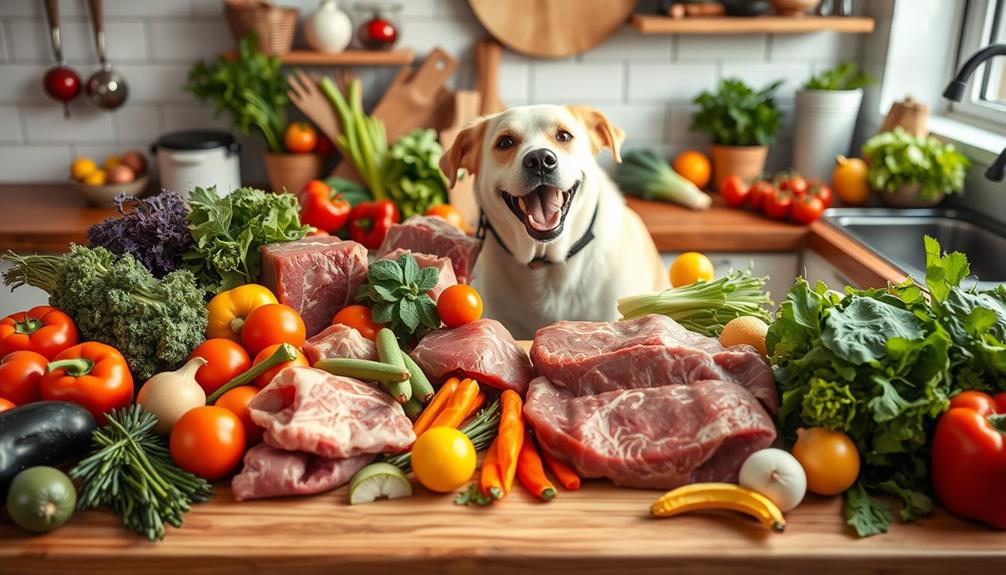
To make raw meals more appealing for your dog, try adding flavorful ingredients like canned sardines or low-sodium bone broth.
Additionally, consider incorporating a variety of textures and flavors inspired by flavorful appetizers to keep your pup intrigued.
Presentation matters too; consider arranging the food in fun shapes or using colorful toppings to spark their interest.
Don't forget to experiment with different protein sources to keep your pup excited about mealtime!
Enhancing Flavor With Additives
Making raw meals appealing for your dog can greatly enhance their eating experience and encourage them to embrace this new diet. By incorporating the right additives, you can create enticing flavors that make mealtime more enjoyable. Exploring various raw food options can also help you identify what excites your dog's taste buds, similar to how coffee enthusiasts explore varieties to find their favorites.
Here are some ingredients to take into account:
- Cheese or favorite treats: Mix these in to boost palatability.
- Canned sardines or low-sodium bone broth: These flavorful additions can make raw food irresistible.
- Goat's milk: A nutritious and tasty option for enhancing flavor.
- Pureed vegetables or fruits: Small amounts can add variety and essential nutrients.
You might also want to lightly sear the meat to release appetizing aromas, gradually reducing this cooking over time as your dog grows accustomed to their raw meals.
Experiment with various toppings and mix-ins to discover which ingredients excite your dog the most. This process not only guarantees a more enjoyable meal experience, but it also allows you to tailor their diet to their specific tastes, making the shift to a raw food diet seamless and enjoyable for both of you.
Creative Meal Presentation Ideas
While your dog's diet is important, how you present their meals can greatly impact their enjoyment and willingness to try raw food. To make raw meals more enticing, consider mixing in low-sodium bone broth or goat's milk for added flavor and moisture.
Lightly searing the meat before serving releases appetizing aromas, enhancing your dog's enthusiasm to dig in. As your dog gets used to the raw meals, gradually reduce the searing. Additionally, be aware of the risks and rewards of Bitcoin IRAs, as understanding potential volatility can be essential when making financial decisions for your pet's health.
Incorporating your dog's favorite treats or a sprinkle of cheese as toppings can also stimulate interest in their new meat-based diet. For a real treat, try adding canned sardines—its strong smell and flavor might make the dish irresistible.
Presentation matters, too! Use puzzle feeders or engaging toys to turn feeding your dog into a fun activity. This creative meal presentation encourages exploration and can make raw meals more exciting.
Experimenting With Protein Sources
Experimenting with different protein sources is essential for finding what your dog enjoys most in a raw food diet. Start by introducing options like boneless chicken, turkey, and lean pork, while being mindful of the importance of selecting the right ingredients for nutritional balance. This approach helps prevent digestive upset from introducing too many new foods at once.
Consider these tips for enhancing your dog's raw meals:
- Incorporate organ meats like liver, making up about 10% of the diet for added nutritional value.
- Use flavor enhancers such as low-sodium bone broth, canned sardines, or goat's milk to make meals more enticing.
- Lightly sear the meat initially to release appealing aromas, gradually reducing this as your dog adapts to raw food.
- Observe your dog's reactions to different protein sources and adjust the diet to create tailored preferences.
Managing Expected Changes
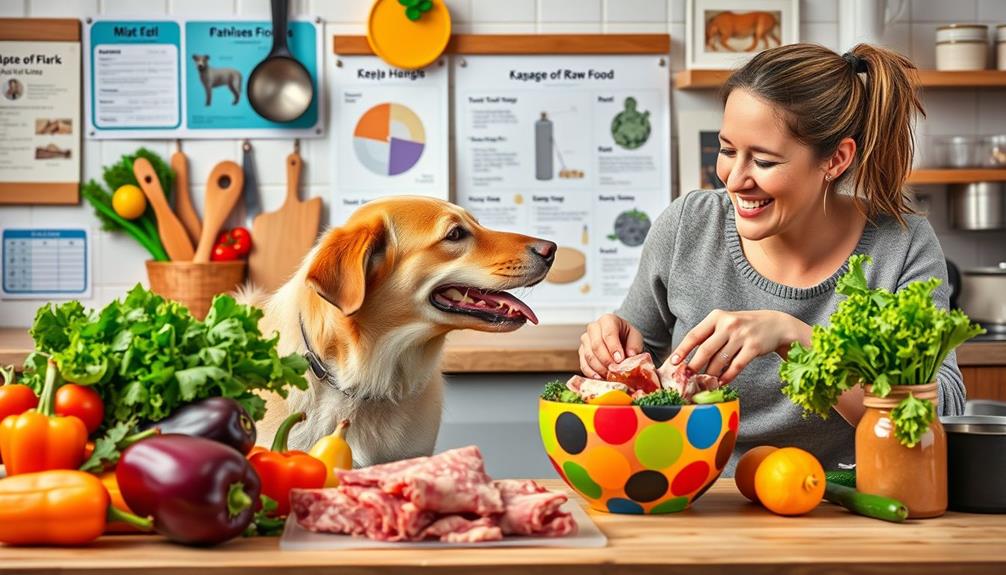
As you shift your dog to a raw food diet, expect some common detox symptoms like vomiting or loose stools.
It's crucial to monitor your dog's stool consistency, as changes may indicate a need for adjustments in their diet.
Additionally, consider incorporating cold medications overview to guarantee your dog remains comfortable during this adjustment.
Don't forget to keep fresh water available, as their hydration needs might shift during this process.
Common Detox Symptoms
Changing your dog to a raw food diet can lead to some expected detox symptoms as their digestive system adjusts to the new nutrition. These symptoms are typically temporary but can include:
- Loose stools
- Vomiting
- Bad breath
- Allergy-like signs (runny eyes and dry skin)
During this shift, you might also notice changes in your dog's overall health, such as improved skin condition or increased energy levels, which can be supported by essential oils for hair growth.
While these detox symptoms might be concerning, they often indicate that your dog's body is adapting. Loose stools can be managed by incorporating plain canned pumpkin into their meals, helping to firm up their stool consistency during the shift.
It's vital to monitor your dog's hydration, as a raw diet may reduce water intake due to the moisture content in raw food. Always make sure fresh water is readily available to keep them hydrated.
If you notice severe symptoms that persist or worsen, consulting a veterinarian is important. This will help rule out any underlying health issues and provide tailored advice.
Monitoring Stool Consistency
Monitoring stool consistency is vital during the change to a raw food diet, as it provides valuable insight into your dog's adaptation process. When shifting, you might notice loose stools initially; this is common as your dog's digestive tract adjusts to new food types.
Incorporating specific routines, similar to how one might use yoga for back pain, can enhance your dog's comfort during this period. Keep an eye on these changes by checking your dog's stool daily.
If you observe persistent loose stools, consider increasing the bone content in their diet, which can help bind the stool and promote firmer results. Generally, dogs produce smaller, firmer stools on a raw diet due to its nutrient density and digestibility compared to kibble.
You may also spot detox symptoms, such as mucus-covered stools, early in the change. While this can be concerning, it usually indicates your dog's body is adjusting to the raw diet and isn't typically a cause for alarm.
Hydration Needs Adjustment
Adjust your dog's hydration routine during the change to a raw food diet, as their water intake may change considerably. With the increased moisture content in raw food, dogs often drink less water. However, it's essential to make sure they always have access to fresh water.
Be mindful that certain treats, like ice cream, can pose health risks for dogs if consumed in excess, particularly due to their lactose content, which can lead to digestive issues.
Pet considerations regarding ice cream
- Monitor their water intake closely.
- Look out for detox symptoms like vomiting or diarrhea.
- Adjust their diet if loose stools occur.
- Consider adding more bone if needed.
During this change, keep an eye on your dog's hydration status. If you notice any detox symptoms, increase their water intake to prevent dehydration.
Loose stools can indicate a dietary imbalance, possibly requiring more bone, which can help regulate hydration. Regularly observe your dog's water intake and stool consistency to gauge their hydration needs.
Selecting Quality Raw Food
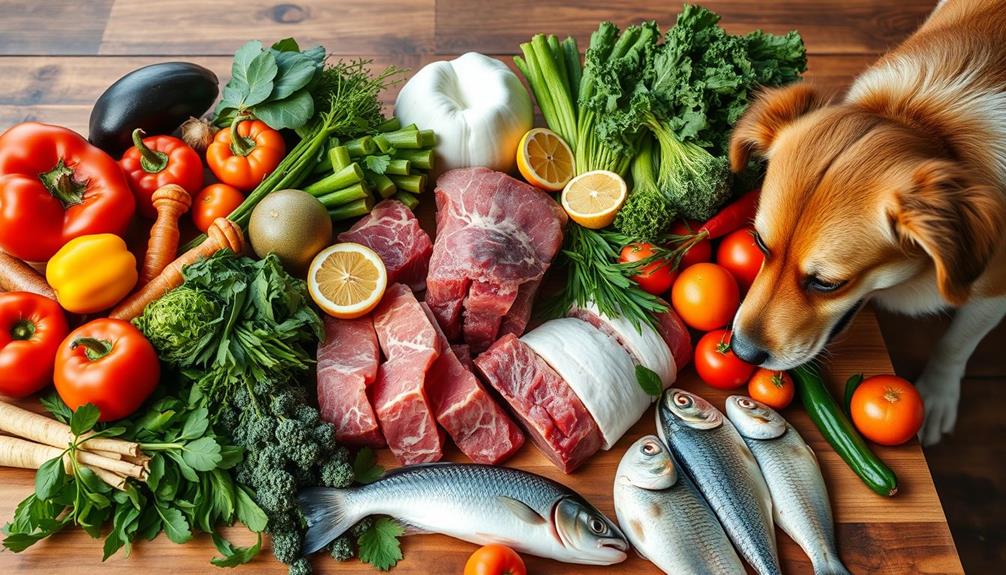
Choosing the right raw food for your dog can greatly impact their health and vigor. Start by prioritizing high-quality meats from reputable sources. Consider incorporating some healthy dog snacks for added variety and engagement, which can promote overall health and wellness healthy dog snacks.
Avoid processed meats, as they often lack the freshness and nutrient density your dog needs. Look for a variety of protein sources, including lean muscle meats and organ meats, which provide essential vitamins and minerals vital for your dog's well-being.
Ensure the raw dog food maintains an appropriate balance of fat, protein, and bone. Aim for fat to make up 10% to 20% of the diet and bones to comprise 10% to 15%, meeting your dog's mineral needs.
Additionally, select raw dog food that includes organic fruits and vegetables, as they offer valuable antioxidants and fiber while steering clear of starchy carbs and high-sugar fruits.
Before making a purchase, research the company's reputation for sourcing transparency and preparation methods. This diligence helps guarantee that you're providing a complete and balanced raw diet for your dog.
Benefits of a Raw Diet

Switching your dog to a raw diet can bring about significant health benefits that enhance their overall well-being. Many pet owners notice remarkable changes in their dogs once they make this switch. Here are some key benefits of a raw diet:
- Improved digestion and nutrient absorption
- Enhanced energy levels and liveliness
- Better dental health due to natural chewing
- Reduction in allergy symptoms and food sensitivities
One of the most notable benefits of a raw diet is improved digestion. You may find that your dog has smaller and firmer stools, a sign that their body is efficiently processing the food.
Additionally, the high-quality, unprocessed nutrients in raw meals lead to enhanced energy levels, allowing your dog to be more active and playful.
Better dental health is another advantage, as the natural chewing of raw meaty bones helps reduce plaque buildup and tartar formation.
Moreover, by avoiding processed ingredients, many dogs experience a decrease in allergy symptoms and food sensitivities.
Frequently Asked Questions
Can I Feed My Dog Raw Fish?
Yes, you can feed your dog raw fish, but make sure it's fresh and sourced from a reputable provider. Watch for any allergies and consult your vet before introducing it into their diet.
What Supplements Are Recommended for a Raw Diet?
When diving into a raw diet, think of your dog as a delicate flower needing proper nourishment. Recommended supplements include fish oil for omega-3s, calcium for bone health, and probiotics to support digestion. Don't skip these essentials!
How Do I Handle Raw Food Storage Safely?
To handle raw food storage safely, keep it in the refrigerator at 40°F or lower. Use airtight containers, label with dates, and freeze any unused portions. Always wash hands and surfaces after handling raw food.
Are There Any Specific Dog Breeds That Shouldn't Have a Raw Diet?
Some breeds, like tiny teacups or those with sensitive stomachs, might not handle a raw diet well. You'll want to consult your vet before taking the plunge, ensuring your dog's health isn't at risk!
Can I Switch My Dog Back to Kibble Later?
Yes, you can switch your dog back to kibble later. Just make sure to do it gradually to prevent digestive issues. Monitor your dog's health and adjust their diet based on their needs and preferences.
Conclusion
Switching your dog to a raw food diet can feel like opening a door to a vibrant, nourishing world. By understanding the concept, making gradual changes, and selecting quality ingredients, you'll not only enhance your pup's health but also deepen your bond. As you watch them thrive, their energy will shine like the sun breaking through the clouds. Embrace this journey, and enjoy the vibrant life that awaits both you and your furry friend!

